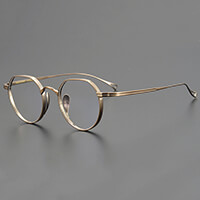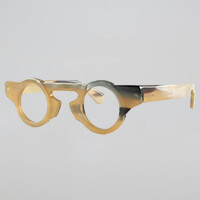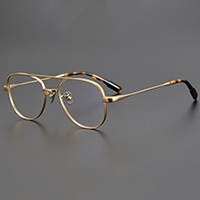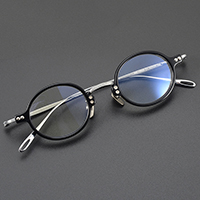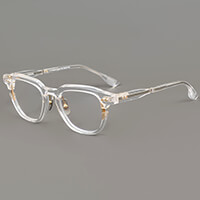OD vs OS: Quick Guide2024-09-24
 |
 |
 |
Imagine standing at the optometrist’s office, staring at your prescription.
Understanding the abbreviations OD and OS can feel confusing.
The terms on your prescription, derived from Latin—oculus dexter (OD) and oculus sinister (OS)—refer respectively to the right and left eyes, critical for correct treatment.
Let's clarify OD vs OS.
Understanding OD and OS
Your visual health relies fundamentally on accurate terminology, particularly when dealing with prescriptions. These terms, though derived from ancient Latin, remain crucial in modern optometry.
OD stands for "oculus dexter," meaning the right eye.
Conversely, OS, short for "oculus sinister," refers to the left eye.
Precision in these abbreviations, including understanding the axis of lenses, ensures the accurate application of prescriptions.
Failing to understand or misinterpreting OD and OS could lead to substantial errors, affecting both diagnosis and treatment.
Therefore, keep these distinctions in mind to preserve and enhance your eye health. Knowing them empowers you to engage more confidently in your eye care conversations.
OD Meaning: An Explanation
OD stands for "oculus dexter," a term originating from Latin.
The phrase itself translates directly to "right eye," an essential designation frequently encountered in the realm of ophthalmology. Health professionals rely on this abbreviation to communicate precise information regarding prescriptions, treatments, and assessments, ensuring the correct application to the specified eye.
Understanding OD is not merely an academic exercise but a critical aspect of effective eye care. When you comprehend this terminology, you can better grasp your medical instructions and maintain clear communication with your healthcare providers, thereby mitigating the risk of potential misapplication.
By familiarizing yourself with "OD," you empower yourself with knowledge. This confidence enables you to actively participate in your healthcare decisions, ensuring accuracy and fostering a positive, collaborative relationship with your eye care professionals. Embrace this understanding as a step toward better visual health and effective treatment outcomes.
OS: What It Means
OS stands for "oculus sinister" in Latin, translating directly to "left eye." This term is pivotal in the field of ophthalmology, as well as optometry, providing a specific designation for accurate eye care.
Medical practitioners frequently use this abbreviation. It signifies prescriptions, treatments, and assessments pertinent to the left eye.
Understanding OS is crucial for patients. It ensures they comprehend their medical instructions accurately and apply treatments correctly.
By familiarizing yourself with the term OS, you gain a better grasp of your eye care regimen, ensuring no missteps in your treatment process.
Empowering yourself with the knowledge of OS fosters a collaborative relationship with your healthcare providers, enabling ou to participate actively in your treatment decisions. It helps mitigate misunderstandings and enhances the precision of care received.
Ultimately, your ability to comprehend and utilize OS in discussions with your vision specialists is a step toward achieving optimal eye health and effective treatment outcomes.
Importance of Knowing OD vs OS
Knowing the terms OD, OS, SPH, CYL, AXIS, ADD, and even your contact lens prescription, is vital, as they direct eye specialists in providing precise care, particularly for conditions like farsightedness and vision correction.
These acronyms, which stand for "oculus dexter" and "oculus sinister" respectively, are fundamental in the realm of optometry and ophthalmology, enabling practitioners to accurately identify and treat each eye. Individuals armed with this knowledge are better equipped to comprehend their eye care prescriptions and ensure effective application of treatments prescribed for either eye.
Moreover, understanding the distinction between OD and OS empowers patients to communicate more clearly with their healthcare providers. This clarity in communication significantly contributes to the effectiveness of medical consultations, ensuring that instructions are followed meticulously and tailored specifically to the needs of each eye.
In summary, the importance of knowing OD vs OS extends beyond merely understanding medical jargon; it represents a proactive approach to personal eye health. This knowledge paves the way for enhanced cooperation with vision specialists, ultimately leading to more precise treatments and superior eye care outcomes. By embracing this understanding, you position yourself optimally to receive the highest standard of care, paving the way for a future of clearer vision and healthier eyes.
Common Uses in Optometry
In optometry, OD and OS signify the right and left eyes.
Optometrists regularly use these abbreviations in prescriptions to indicate which eye requires specific treatments or lenses, including specifications for lens power, prism adjustments, and contact lens prescription details.
Beyond prescriptions, OD vs OS helps streamline communication in clinical settings, ensuring accuracy in diagnostic processes and treatment plans.
These terms are vital for documenting patient history, assessing vision progress, addressing conditions like astigmatism, nearsighted or farsighted presbyopia, and making precise adjustments in corrective lenses and eye therapies.
Professionals rely on OD and OS to maintain consistency and precision, ultimately enhancing patient care.
How to Read Eye Prescriptions

Reading an eye prescription might seem daunting at first, but understanding key abbreviations like OD vs OS makes it much simpler.
OD stands for "oculus dexter," meaning the right eye, while OS denotes "oculus sinister," signifying the left eye. Familiarizing yourself with these abbreviations empowers you to decipher specific treatment suggestions accurately.
The terms "sphere" and "cylinder" further describe corrections for refractive errors.
Interpreting OD in Prescriptions
When interpreting OD in prescriptions, one must recognize its significance as "oculus dexter," meaning the right eye. This distinction is crucial for accurate treatment application.
Understanding this abbreviation ensures clarity in communication between healthcare professionals and patients, fostering trust and precision in care delivery. Abbreviations like OD are foundational to effective eye care.
OD signifies the right eye, derived from the Latin term "oculus dexter."
By familiarizing oneself with OD, patients and practitioners can seamlessly navigate eye prescriptions. This knowledge leads to exactness in corrective measures, enhancing overall visual health outcomes. Mastering abbreviations such as OD is a testament to one's dedication to fostering exemplary patient care.
Interpreting OS in Prescriptions
When deciphering eye prescriptions, "OS" stands for "oculus sinister," indicating the left eye.
- 1. Historical Context: "Oculus sinister" is derived from Latin, signifying the left eye.
- 2. Application: Differentiating between OS and OD is vital for precise treatment.
- 3. Patient Communication: Understanding these terms enhances clarity in patient care.
OS ensures specific instructions pertain to the left eye, ensuring targeted treatment.
Accurate interpretation of OS aids in delivering tailored and effective visual care solutions, fostering patients' trust.
Differences Between OD and OS Eye
Understanding the differences between OD (oculus dexter) and OS (oculus sinister) is a crucial aspect of comprehending eye-related terminologies. These abbreviations, though small, hold significant meanings in the realm of optometry.
OD designates the right eye, while OS refers to the left eye.
This differentiation facilitates specific, accurate treatment for each eye, maximizing patient care and outcomes.
When reading prescriptions, recognizing whether a value applies to OD or OS helps avoid misconceptions and errors.
Moreover, precise identification of OD and OS ensures the formulation of individualized treatment plans, especially important for patients with astigmatism, fostering enhanced visual health.
Ultimately, mastering the distinction between OD and OS is instrumental in delivering superior, patient-specific eye care, ou.
How OD and OS Affect Vision Care
The notations of OD and OS are fundamental in vision care, defining right and left eye specifications, respectively.
Optometrists utilize these abbreviations to design comprehensive eye care strategies. By distinguishing between OD and OS, practitioners can tailor treatments to the unique needs of each eye, thereby optimizing visual health and outcomes. This meticulous attention to detail significantly boosts precision in diagnosing and treating ocular conditions.
Furthermore, accurate usage of OD and OS, along with the correct measurement of diopters, is crucial when preparing eyeglass or contact lens prescriptions. Ensuring that each lens corresponds to the correct eye mitigates the risk of visual discrepancies and enhances the patient's corrective eyewear experience. Consequently, heightened accuracy in prescriptions promotes overall satisfaction and trust in vision care services.
Overall, the precise application of OD and OS in vision care enables professionals to devise customized treatment plans. This attention to detail not only elevates the standard of care but also reassures patients that their specific vision needs are being meticulously addressed, fostering trust and confidence in their vision care providers.
Tips for Remembering OD vs OS
To remember OD versus OS, associate OD with the Latin term "oculus dexter" meaning right eye.
Similarly, OS stands for "oculus sinister," which corresponds to the left eye. Visualizing the "D" in OD as pointing to the right and the "S" in OS as swerving to the left can create substantial mnemonic aids. Additionally, think of dexterity, often linked with the right hand, to recall OD.
Another strategy is to use a physical reference like pointing to your right eye when you think of OD. This embodied cognition technique, where you utilize your physical movements to reinforce memory, enhances retention and helps avoid mix-ups.
Finally, employ repetition and visualization techniques in professional settings to reinforce these distinctions. For instance, repeatedly labeling anatomical diagrams with OD and OS or engaging in routine verbal discussions about each term can solidify this knowledge. These consistent efforts foster lasting recall and precision in clinical practices, thereby promoting accuracy and efficacy in vision care.
Common Mistakes to Avoid
Confusing OD and OS can lead to significant errors in patient treatment and care, particularly if conditions like astigmatism are involved. Misinterpreting these terms may result in incorrect prescriptions and faulty diagnoses.
Always double-check each notation carefully to ensure accurate application. A minor slip can have major consequences.
Consider separating OD and OS entries spatially on patient charts to avoid mix-ups. This visual distinction reduces the risk of error during fast-paced clinical activities.
Despite initial confidence, remember that periodic reviews of these terms maintain sharpness. Leveraging digital reminders and cross-verifying with colleagues can reinforce knowledge and prevent costly misunderstandings. Employing phrases such as "right as might" for OD and "left before rest" for OS might further embed these distinctions securely.
When to Consult an Eye Specialist
Are you wondering when it's necessary to seek the expertise of an eye specialist regarding eye health or vision concerns?
Researchers highlighted a growing urgency for early diagnosis of eye conditions. Early consultations can drastically improve long-term vision outcomes, addressing issues before they become severe.
If you're experiencing persistent eye discomfort, it's paramount to consult a specialist. This ensures any underlying condition is diagnosed and treated promptly, safeguarding your valuable vision.
Frequent headaches, sudden vision changes, trouble seeing at night, astigmatism, or nearsightedness are significant indicators. Persistent issues like these shouldn’t be ignored, and visiting a specialist can lead to effective, personalized treatment solutions.
Regular eye exams not only detect vision changes but also prevent potential complications, bringing reassurance and clarity to your eye health journey.

- About Olet Optical
- Affordable Glasses Online for Every Budget
- Contact Us
- Customer Reviews
- Returns & Replacements
- Shipping & Payment
- Terms of Use
- Privacy Policy
- Infringement Policy
- Site Map
- Olet Blog
- User Center
- Register
- My Account
- Forget Password
- My Orders
- Tracking Order
- Refer a Friend
- Customs & Taxes
- Influencer Program
- How to Measure Pupillary Distance
- How to Measure Glasses Size
















